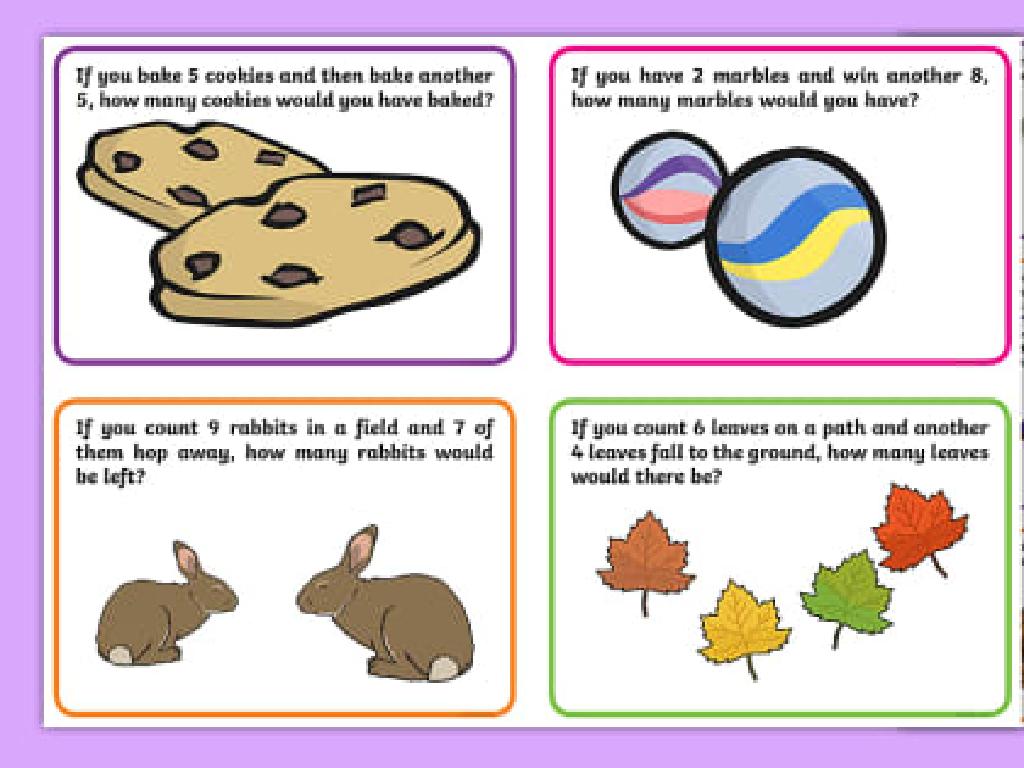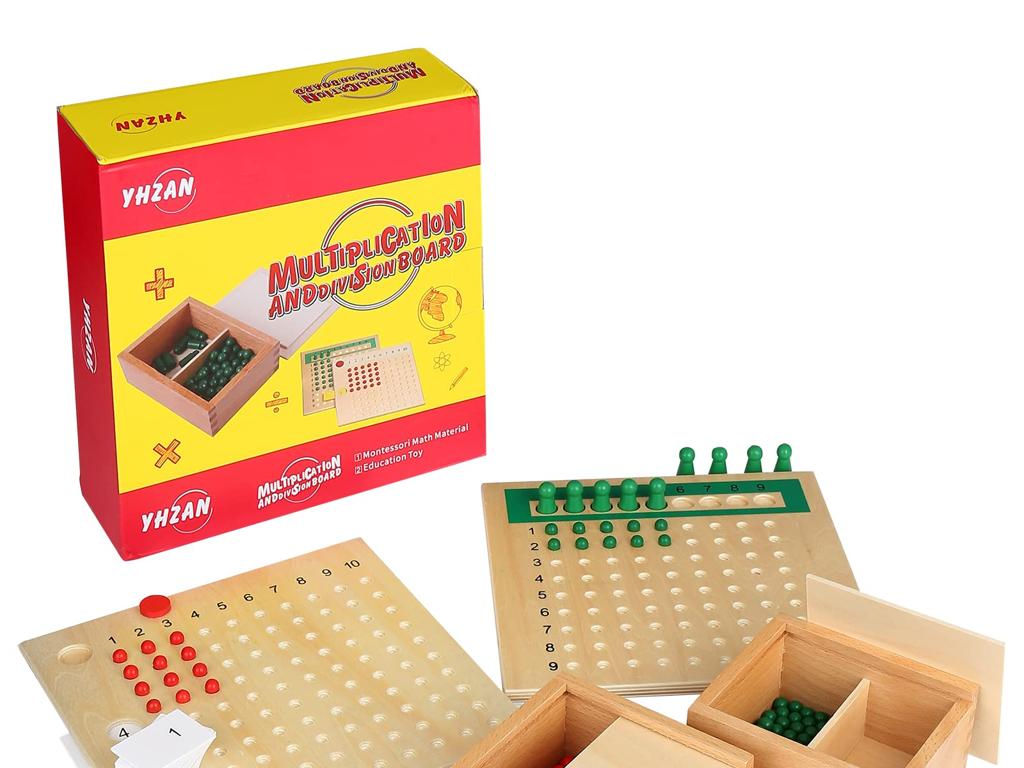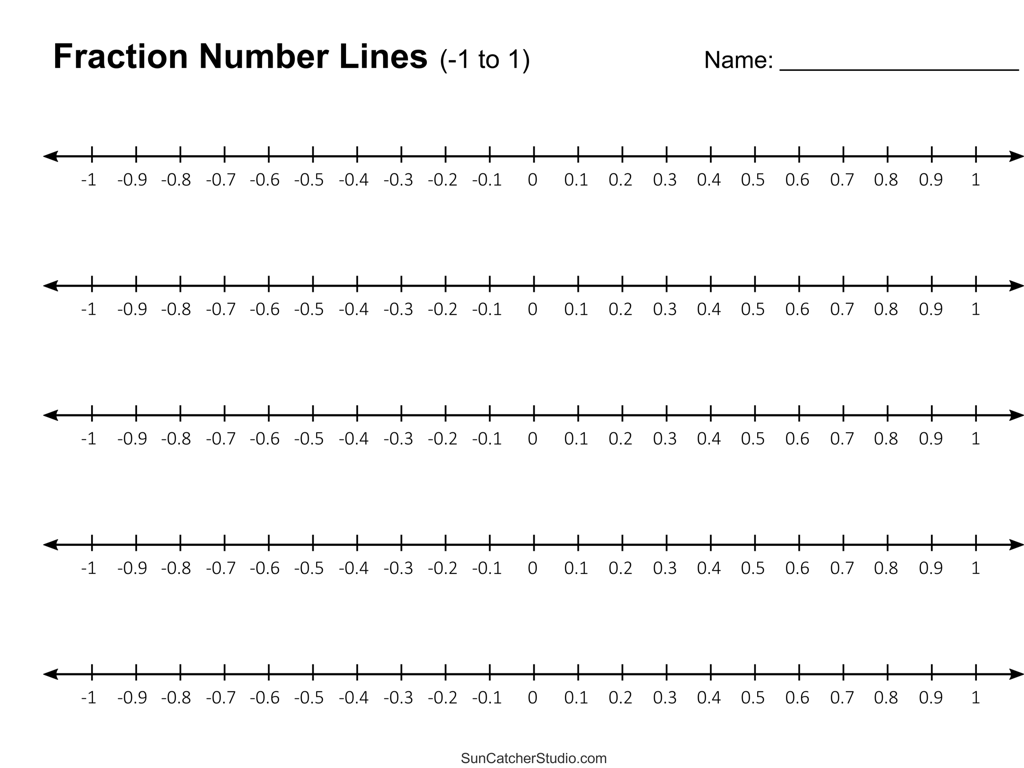Break Apart A Two-Digit Number To Subtract
Subject: Math
Grade: Second grade
Topic: Subtraction Strategies: Two Digits
Summary: This second-grade math presentation teaches students effective subtraction strategies by breaking apart two-digit numbers into tens and ones. Through hands-on examples, class activities, and interactive games like Subtraction Bingo, students learn how to simplify subtraction without confusion. The break-apart method strengthens place value understanding and builds confidence for tackling more complex math problems. Students practice with visual aids, share methods, and complete worksheets to reinforce their skills both in class and at home.
Please LOG IN to download the presentation. Access is available to registered users only.
View More Content
Breaking Apart Numbers for Subtraction
– Learn a new subtraction strategy
– Break apart numbers into tens and ones
– For 54, break it into 50 (tens) and 4 (ones)
– Understand why it simplifies subtraction
– Smaller numbers are easier to subtract
– Practice with examples
– Example: 54 – 26 becomes (50 – 20) and (4 – 6)
|
Today’s lesson introduces a new subtraction strategy that will help students manage two-digit subtraction problems more easily. By breaking apart numbers into tens and ones, students can subtract smaller, more manageable numbers, which simplifies the process and reduces the likelihood of errors. This method also reinforces the concept of place value. During the lesson, provide several examples and guide students through the process of breaking apart numbers and subtracting each place value separately. Encourage students to explain their reasoning and share their methods with the class to foster a deeper understanding.
Understanding Subtraction: Two-Digit Numbers
– What is subtraction?
– Subtraction means taking away numbers.
– Review one-digit subtraction
– Remember how we subtract smaller numbers?
– Introduce two-digit subtraction
– Now we’ll try with bigger numbers, like 15 – 7.
– Example of breaking apart numbers
– Let’s break 15 into 10 and 5, then subtract 7 from 10 first.
|
This slide is aimed at helping second-grade students grasp the concept of subtraction by first reinforcing their understanding of subtracting one-digit numbers. Begin by defining subtraction as the process of taking one number away from another. Review simple subtraction by using examples of one-digit numbers that the students are already familiar with. Then, introduce the concept of two-digit subtraction by providing a clear example, such as 15 – 7. Demonstrate how to ‘break apart’ a two-digit number into tens and ones to make subtraction easier. For instance, show that 15 can be broken down into 10 and 5, and then subtract 7 from 10, which is simpler. This method helps students manage larger numbers by using the skills they have already mastered with smaller numbers.
Breaking Apart Numbers to Subtract
– Every number has tens and ones
– How to break apart a two-digit number
– Split the number into tens and ones
– Example: Breaking apart 54
– 54 becomes 50 (tens) + 4 (ones)
– Practice with different numbers
– Try breaking apart 63, 78, or 85
|
This slide introduces the concept of place value and how to break apart two-digit numbers into tens and ones, which is a foundational skill for understanding subtraction. Start by explaining that every two-digit number is made up of tens and ones. Use visual aids like base-ten blocks or drawings to show 54 as an example, breaking it into 50 and 4. Encourage students to practice with different numbers, reinforcing the concept that the first digit represents tens and the second digit represents ones. This will help them grasp how to subtract by breaking apart numbers, making it easier to manage larger numbers in future lessons.
Breaking Apart Numbers for Easy Subtraction
– Simplifies subtraction process
– Breaking numbers into tens and ones makes it less complex
– Subtract tens, then ones separately
– Like 50 – 20 is easier than 57 – 28
– Visual examples aid understanding
– Pictures of 57 – 28 with blocks or drawings help visualize
|
This slide introduces the concept of breaking apart numbers into tens and ones to simplify the subtraction process. It’s important for students to understand that by separating the tens and ones, they can perform subtraction more easily without getting confused. Start by explaining that we can subtract the tens place numbers first and then the ones place numbers. Use visual aids like blocks or drawings to show, for example, how to subtract 57 – 28 by first taking away 50 – 20, and then subtracting the remaining 7 – 8. This method helps students avoid the often confusing process of borrowing. Encourage students to practice with different numbers and use visual aids to reinforce the concept.
Let’s Try Together: Breaking Apart Numbers to Subtract
– Work through a subtraction problem
– Break apart the two-digit number
– Separate the tens and ones in the number
– Subtract tens, then ones
– First subtract the tens place, then the ones place
– Combine results for the answer
– Add both differences to find the total subtraction
|
This slide is designed for a class activity where the teacher and students will work together on a subtraction problem. The teacher will guide the students to understand how to break apart a two-digit number into tens and ones. For example, in 52 – 29, break 52 into 50 (tens) and 2 (ones). Subtract the tens (50 – 20 = 30), then the ones (2 – 9, remember to borrow 10 from the tens). After subtracting both parts, combine the results to find the final answer. This method helps students understand the value of each digit and simplifies the subtraction process. The teacher should prepare several examples to practice with the class and ensure that each student can try the method with guidance.
Practice Time: Breaking Apart Numbers
– Complete the worksheet individually
– Break apart numbers to subtract
– For 52 – 29, break into 50 – 20 and 2 – 9
– Solve the subtraction problems
– Check your work with a partner
– Discuss your answers and methods
|
This slide is for a practice activity where students will apply the strategy of breaking apart two-digit numbers to subtract. Provide worksheets with several subtraction problems. Guide students to decompose the numbers into tens and ones, subtract them separately, and then combine the results. After completing the worksheet, students should pair up to compare answers and discuss the strategies they used. This peer interaction reinforces learning and allows students to learn from each other. As a teacher, circulate the room to offer help and ensure that students understand the concept. Possible variations of the activity could include using manipulatives, drawing models, or creating a game where students race to solve problems correctly.
Share Our Findings: Breaking Apart Numbers
– Students present their subtraction methods
– Discuss challenges faced in the activity
– Did anyone find it tricky to break apart numbers?
– Show correct subtraction examples
– For example, 52 – 29 becomes 50 – 20 and 2 – 9
– Reinforce the break-apart strategy
– Practice makes perfect! Let’s try more together.
|
This slide is designed for a collaborative classroom discussion where students will share their experiences with the break-apart strategy for subtraction. Encourage students to explain how they separated the tens and ones to subtract two-digit numbers. Open the floor for students to discuss any difficulties they encountered, fostering a supportive environment where challenges are addressed collectively. Use correct examples to reinforce the concept, such as breaking apart 52 into 50 and 2, then subtracting 29 by taking away 20 first and then 9. This reinforces their understanding and demonstrates the practical application of the strategy. Provide additional examples and encourage students to practice more problems to gain confidence in using this method.
Class Activity: Subtraction Bingo
– Play Subtraction Bingo together
– Each spot is a 2-digit subtraction
– Problems like 54 – 29 on the spots
– Solve problems to mark spots
– Use ‘break apart’ strategy to solve
– Aim for a Bingo!
|
This interactive class activity is designed to help second-grade students practice the ‘break apart’ subtraction strategy with two-digit numbers. Set up the bingo cards with various two-digit subtraction problems in each spot. Students will solve these problems using the ‘break apart’ method, where they separate the tens and ones to subtract more easily. When a student solves a problem correctly, they can mark that spot on their bingo card. The goal is to get five correct answers in a row, column, or diagonal for Bingo. Possible variations of the activity could include group play, timed challenges, or using candy or stickers as markers to increase engagement. This activity reinforces mental math skills and the understanding of place value in subtraction.
Conclusion & Homework: Break Apart Method
– Review breaking apart numbers
– Complete the subtraction worksheet
– Practice with problems like 54 – 29
– Use break apart method for homework
– Break down numbers into tens and ones
– Remember to show your work
– This helps you understand each step
|
As we wrap up today’s lesson on breaking apart numbers to subtract, let’s go over the key points we’ve learned. Ensure students are comfortable with the concept of decomposing numbers into tens and ones to simplify subtraction. For homework, students will receive a worksheet with two-digit subtraction problems to reinforce today’s lesson. Remind them to apply the break apart method to each problem and to show all the steps they take. This will help solidify their understanding and prepare them for more complex subtraction tasks. Encourage them to ask questions if they’re unsure about the process during homework.





